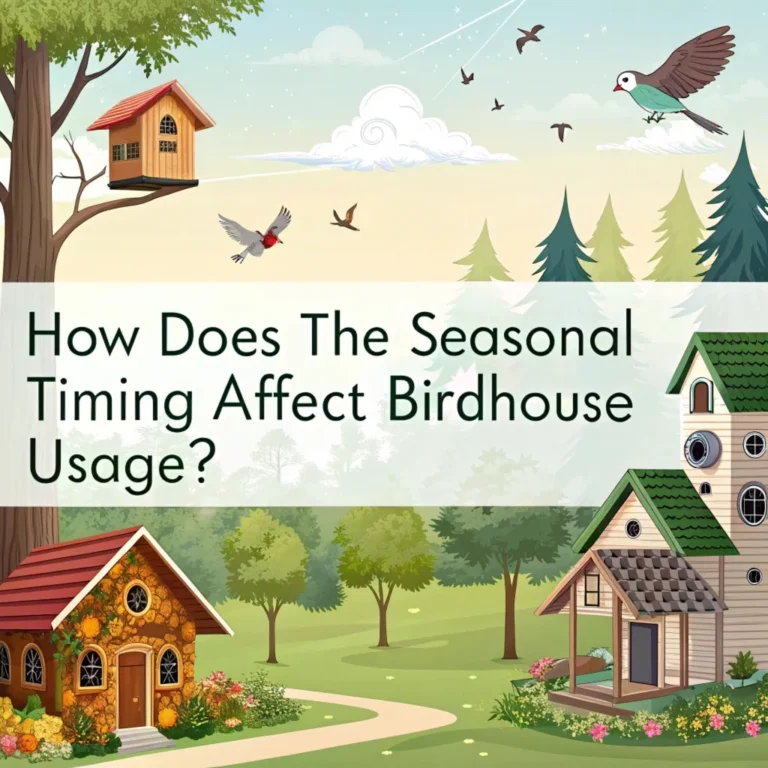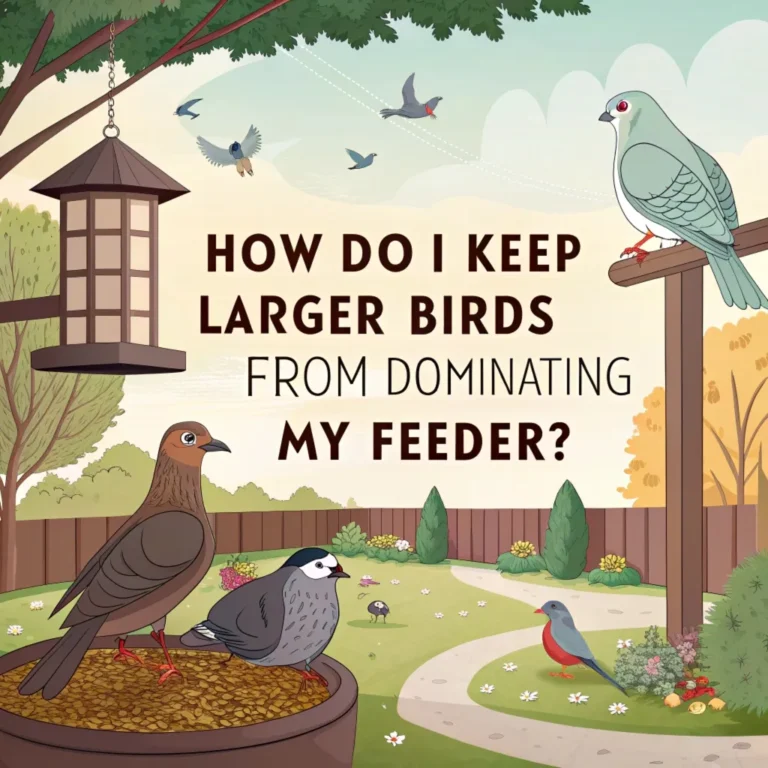What Should You Do if Birds Abandon Your Birdhouse?
Birds often build nests in birdhouses, creating a safe space for their eggs and young.
However, sometimes these nests are abandoned, leaving homeowners unsure of what to do next.
This guide explains why birds might leave their nests and provides steps to take if you find an abandoned birdhouse.

Key Takeaways
- Wait and observe: Don’t assume a nest is abandoned immediately. Birds may be away for extended periods.
- Identify reasons: Common causes for nest abandonment include predator threats, human disturbance, and non-viable eggs.
- Legal considerations: Most bird nests are protected by law. Don’t remove active nests.
- Safety first: If intervention is necessary, use caution and consider contacting wildlife experts.
- Prevention: Take steps to make your birdhouse more appealing and safe for future nesting.
- Learn from experience: Use abandoned nests as an opportunity to improve your birdhouse setup.
- Timing matters: Wait at least four weeks before declaring a nest abandoned.
- Proper disposal: If confirmed abandoned, clean the birdhouse safely and dispose of materials properly.
- Record keeping: Document your observations for future reference and local bird studies.
- Continuous improvement: Adjust your birdhouse placement and design based on your experiences.
Understanding Bird Nest Abandonment
Birds abandon their nests for various reasons. Understanding these factors helps in addressing the issue effectively.
Nest abandonment is a complex behavior influenced by both environmental and biological factors. Stress, predation risk, and resource availability all play crucial roles in a bird’s decision to leave its nest.
Observing bird behavior around the nest can provide valuable insights into the reasons for abandonment. Pay attention to the frequency of adult visits, any signs of distress, or unusual activity in the surrounding area.
This information can help you determine whether intervention is necessary or if the birds are simply following their natural instincts.
Common Reasons for Nest Abandonment

Birds may leave their nests due to several factors:
- Predator threats: Birds sense danger and leave to protect themselves.
- Human disturbance: Frequent human activity near the nest can cause stress.
- Non-viable eggs: Birds may abandon eggs that won’t hatch.
- Weather conditions: Extreme temperatures or storms can drive birds away.
- Food scarcity: Lack of nearby food sources may force birds to relocate.
Environmental changes can significantly impact a bird’s decision to abandon its nest. Sudden alterations in the surrounding habitat, such as tree removal or construction, can make the area less suitable for nesting.
Additionally, the presence of invasive species or new predators in the area can increase the perceived risk for nesting birds.
Timing is also crucial in nest abandonment. Some species are more likely to abandon nests early in the breeding season, when they have a better chance of successfully re-nesting elsewhere.
Signs of an Abandoned Nest
Identifying an abandoned nest requires careful observation:
- No adult activity: Adults absent for extended periods.
- Cold eggs: Eggs feel cold to the touch.
- Unchanged nest: No new materials added over time.
- Predator signs: Evidence of disturbance or attack.
Careful monitoring is essential when determining if a nest has been abandoned. Keep a log of your observations, noting the times and durations of adult bird activity.
This information can be valuable in assessing whether the nest is truly abandoned or if the birds are simply following their natural patterns of behavior.
Visual cues can also indicate abandonment. Look for signs of neglect, such as accumulated debris in the nest or unhatched eggs well past their expected hatching date. However, avoid disturbing the nest unnecessarily, as your presence could inadvertently cause abandonment.
Legal Considerations

Most bird nests are protected by law. The Migratory Bird Treaty Act prohibits the removal of active nests without proper permits.
Understanding the legal implications of interfering with bird nests is crucial for anyone dealing with an abandoned birdhouse.
The Migratory Bird Treaty Act provides broad protection for most native bird species in the United States, making it illegal to disturb, remove, or possess nests, eggs, or birds without proper authorization.
Local regulations may also apply, so it’s important to check with your state’s wildlife agency before taking any action. Some areas may have additional protections for certain species or during specific times of the year.
Waiting Period Before Action
Experts recommend waiting at least four weeks from the last adult sighting before declaring a nest abandoned.
Patience is key when dealing with potentially abandoned nests. Birds may leave their nests for extended periods during the day to forage or distract predators.
The four-week waiting period allows for natural variations in nesting behavior and ensures that you don’t inadvertently interfere with an active nest.
During this time, continue to observe the nest from a distance, noting any signs of activity. This waiting period also allows for the possibility of late-season nesting attempts, which are common in some species.
Steps to Take for an Abandoned Birdhouse
Follow these steps if you suspect your birdhouse is abandoned:
- Observe from a distance: Use binoculars to monitor activity.
- Document activity: Keep a log of bird presence or absence.
- Check for eggs or chicks: Look for signs of life in the nest.
- Consult experts: Contact local wildlife authorities for advice.
Maintaining a safe distance is crucial when monitoring a potentially abandoned birdhouse. Use binoculars or a spotting scope to observe the nest without disturbing the area.
This approach minimizes the risk of causing abandonment due to human presence.
Detailed documentation can provide valuable insights into bird behavior and help determine if intervention is necessary.
Record the date, time, and duration of any observed activity, as well as weather conditions and any unusual events in the area.
Handling Abandoned Eggs
If you find abandoned eggs:
- Don’t touch: Avoid handling eggs unless necessary.
- Consult experts: Contact a wildlife rehabilitator for guidance.
- Remove if confirmed abandoned: Dispose of eggs properly after expert confirmation.
Proper handling of abandoned eggs is crucial for both legal and ethical reasons. In most cases, it’s best to leave the eggs undisturbed unless you’ve received explicit instructions from a wildlife expert.
Eggs that have been exposed to the elements for an extended period are unlikely to be viable.
If removal is necessary, wear gloves and dispose of the eggs according to local regulations. Some areas may have specific guidelines for handling wildlife remains, including unhatched eggs.
Cleaning an Abandoned Birdhouse
Once confirmed abandoned:
- Wait for the right time: Ensure the nesting season is over.
- Wear protective gear: Use gloves and a mask.
- Remove old nesting material: Dispose of it away from the birdhouse.
- Clean thoroughly: Use a mild soap solution and rinse well.
- Allow to dry: Ensure the birdhouse is completely dry before closing.
Proper cleaning of an abandoned birdhouse is essential for maintaining a healthy environment for future nesting birds.
Timing is crucial; wait until you’re certain the nesting season has ended to avoid disturbing late-season nesters.
When cleaning, use a mild soap solution and avoid harsh chemicals that could leave residues harmful to birds.
Thorough drying is important to prevent mold growth, which can be detrimental to future nesting attempts.
Preventing Future Abandonment
Take steps to make your birdhouse more appealing:
- Proper placement: Position away from high-traffic areas.
- Predator guards: Install baffles or other protective devices.
- Regular maintenance: Clean and repair birdhouses annually.
- Provide food sources: Plant native species that attract birds.
Creating an ideal environment for nesting birds can significantly reduce the likelihood of abandonment.
Consider the specific needs of the bird species you’re hoping to attract, including their preferred habitat and nesting height.
Native plantings not only provide food sources but also create a more natural and appealing environment for birds. Research local plant species that offer seeds, berries, or attract insects that birds feed on.
Learning from Abandoned Nests
Use the experience to improve your birdhouse setup:
- Analyze location: Consider moving the birdhouse to a better spot.
- Adjust design: Make modifications for better ventilation or protection.
- Monitor local bird populations: Stay informed about species in your area.
Each abandoned nest provides an opportunity to learn and improve your birdhouse setup. Analyze the factors that may have contributed to the abandonment, such as nearby disturbances, inadequate protection, or unsuitable design features.
Staying informed about local bird populations can help you tailor your birdhouse offerings to the needs of species in your area.
Consider participating in local birdwatching groups or citizen science projects to gather more information about bird behavior and preferences in your region.
When to Seek Professional Help
Contact wildlife experts if:
- You find injured birds: They need immediate professional care.
- You’re unsure about abandonment: Experts can provide definitive answers.
- Legal questions arise: Professionals know bird protection laws.
Professional assistance can be invaluable when dealing with complex situations involving abandoned nests or injured birds.
Wildlife rehabilitators have the expertise and resources to provide appropriate care and can offer guidance on legal and ethical considerations.
Building a relationship with local wildlife experts can also provide ongoing support and education, helping you become a more effective steward of your local bird population.
FAQs
How long does it take for birds to abandon a nest?
Birds may leave their nests for various periods. Wait at least four weeks before considering a nest abandoned.
Can I remove an abandoned nest from my birdhouse?
You can remove a nest if you’re certain it’s abandoned. Wait until the end of nesting season and follow proper cleaning procedures.
What should I do if I find abandoned eggs in a birdhouse?
Consult a wildlife rehabilitator before taking any action. They can provide guidance on handling abandoned eggs.
How can I make my birdhouse more attractive to nesting birds?
Ensure proper placement, add predator guards, and maintain the birdhouse regularly. Providing nearby food and water sources also helps.
Is it legal to remove an active bird’s nest?
No, it’s generally illegal to remove active nests. Most bird nests are protected by federal law.
How often should I clean my birdhouse?
Clean birdhouses annually, preferably in late fall or early spring before the nesting season begins.
What signs indicate that a nest is still active?
Regular adult bird activity, warm eggs, and the presence of hatchlings or fledglings indicate an active nest.
Can abandoned nests attract pests?
Yes, old nests can attract insects and other pests. This is why regular cleaning is important.
Should I provide nesting materials for birds?
You can offer nesting materials like small twigs, grass clippings, and pet hair, but place them near the birdhouse, not inside.
How can I tell if eggs in a nest are viable?
It’s best to leave this determination to experts. Avoid handling eggs unless advised by a wildlife professional.

Luna is the passionate founder and author of Birds and You, a website dedicated to sharing her love for birds with fellow enthusiasts. Through her engaging articles and guides, she aims to educate and inspire others to explore the fascinating world of birds. When she’s not writing, you can find Luna observing birds in their natural habitats or sharing beautiful bird photography on Pinterest. Join her on this journey to celebrate and protect our feathered friends!







